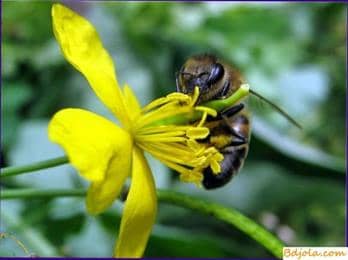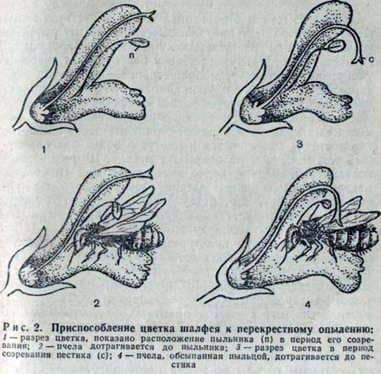Allocation of nectar flowers of honey plants

Nectar is a sweet liquid with an admixture of organic and mineral substances emitted by flowers and other glandular cells of plants. Allocate nectar to about a thousand species of plants, which are united under the general name of honey (or, more precisely, call them nectariferous). More often nectar is allocated by special cells collected in structural nectar tissues, covered with a common skin (skin). In different plant species, nectaries have a variety of shapes: flat, convex, spherical, etc. In the nectary shell, there are many stomata through which the nectar is released and accumulates in the form of transparent droplets.

In the vast majority of honey plants, nectaries are at the base or in the depth of the flower. For example, in a meadow clover, nectaries are located at the base of a deep flower tube, in blueberry flowers – on stamens from the side of petals, sunflower – on the inside of the base of the petals, and at the base of the ovary. In some plants, nectaries as separate organs do not exist, and special cells that make up one of the flower tissues separate out nectar. Thus, in the flowers of lime, the nectar is excreted by cells scattered in the form of tubercles at the base of the sepals; in the flowers of the mullein – at the base of the corolla.
Some plants, in addition to the nectaries within the flowers, also have non-flowered nectaries located on leaves, petioles, stems. For example, in the sweet cherry, nectaries are found on the petioles of leaves, in stern beans on stipules, and on cotton on the underside of leaves. The nectar produced by them does not matter for the pollination of flowers, but it attracts pollinating insects to plants of this species. This nectar also attracts ants that destroy small insect pests.
In flowers, nectar is extracted for attracting bees and other

In flowering nectaries, the nectar always stands and accumulates in such a place of the flower that the bee or other insect, reaching for the nectar, come into contact with the anthers or be dusted with pollen from those near the anthers. Pollen-covered bee, flying from one flower to another, comes into contact with the moist and sticky stigma of the pistil and thus performs pollination.
Nectar begins to stand out only after full disclosure of the flower. At the first blossoming flowers on the plant, nectaries are larger, and they are more prominent in nectar than later flowering and especially blossoming at the end of flowering. Periodic selection of nectar by insects contributes to its greater isolation. After complete pollination and fertilization, the nectar remaining in the flower is absorbed back into the cells and expended on the growth of the ovary.
The amount of nectar that flowers can isolate depends primarily on the hereditary characteristics of the plant. The abundant release of nectar is characterized by flowers of lime, buckwheat, willow-tea and other plants; under the most favorable conditions, most plants release 5-10 times less nectar. Nectar production of plants is usually determined in terms of 1 hectare, entirely occupied by this plant, and in terms of the amount of the extracted sugar in nectar for the entire flowering time.
To a large extent, the nectar production of plants depends on the conditions of growth and weather during flowering.
The selection of nectar depends on the degree of development of the plant, on the total surface of its leaves. In this respect, agricultural crops and plantations are of great importance for agricultural honey crops. High agricultural technology favors the good development of plants, more flowers developing on it, increases their nectar production. Addition of fertilizers gives a significant increase in nectar.
For example, superfosphate and phosphate fertilizers have a positive effect on the productivity of nectar and buckwheat productivity. Yield and nectar production of field and garden crops increase protective forest belts where plants develop and bloom under more favorable conditions than in open places. Broad-ripening buckwheat crops yield higher yields (and more nectar) than bad crops. It is proved that all the techniques of agricultural technology, which contribute to increasing the yield of agricultural crops, simultaneously increase their nectar production.
Different varieties of cultivated plants may differ in the nectariness of flowers. Different varieties of buckwheat per 1 hectare give in nectar from 50 to 137 kg of sugar; During the test, more nectariferous varieties were also more productive. It is clear that the beekeeper is interested in the farms planting buckwheat of the most non-nutritive varieties.
The decisive influence on the release of nectar is caused by the weather during the flowering of plants. The most favorable air temperature for nectar is 20-30 њ C; both with increasing and decreasing temperature, the release of nectar is reduced, and at a temperature of 10-12 њ C it stops completely. The most favorable relative air humidity is 60-80% .The moisture of the soil is also important, plants do not excrete nectar in dry soil. soil is in the range of 50-60%.
Particularly favorable conditions for nectar are created on warm nights.
In the flowers of many plant species, nectar accumulates overnight, which the bees harvest early in the morning. On cool nights, nectar does not stand out and only appears during the day when it’s warming. The concentration of sugar in nectar ranges from 5 to 70%. The most intensive bees collect nectar at a sugar concentration of about 50%. At a concentration of 10% and below the bees do not take nectar. During the day, the concentration of sugar in dry weather rises, in damp and rainy – decreases. In open flowers in hot weather, nectar can thicken so much that it becomes inaccessible to bees. Some plants have in the flower arrangements that protect the nectar from drying out. Rain in open flowers washes off the nectar, which leads to the termination of summer bees on such plants. In flowers, facing downwards or having well-protected nectaries,
Allocation of nectar flowers of honey plants
